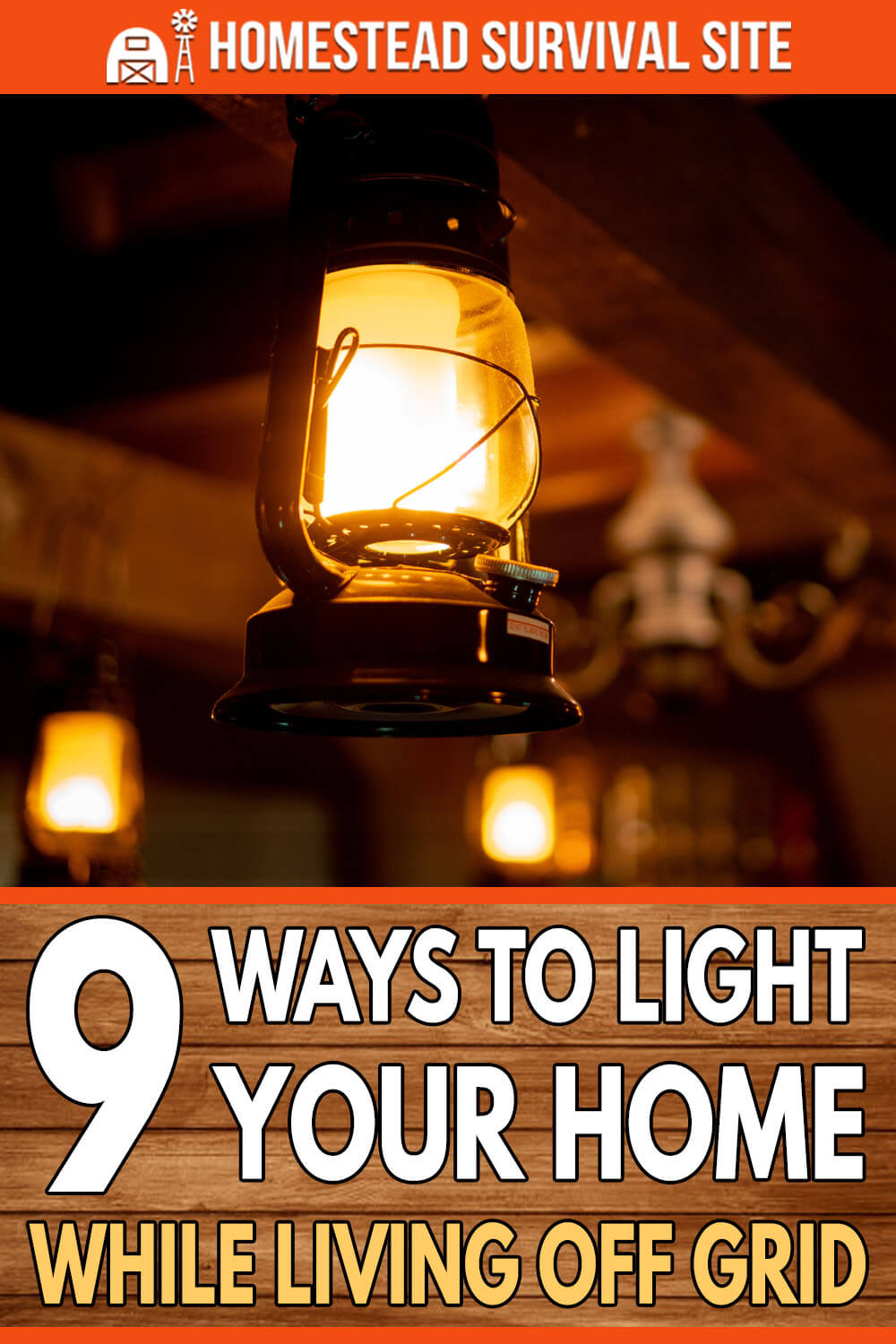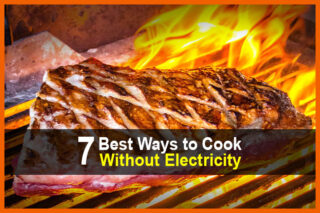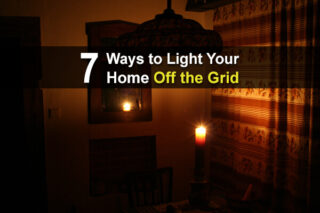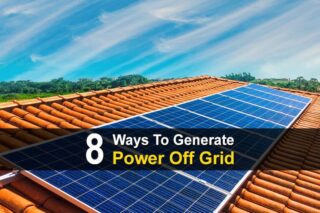Estimated reading time: 7 minutes
The decision to go 100% off the grid comes with some major challenges. If you're thinking of doing this, then hopefully, you understand how much things will change. Most modern-day comforts will disappear. Fortunately, these comforts will be replaced by newfound freedoms.
Living life requires light. You need light to read, work, wash, or see your loved ones. And for most of the day, the sun will offer its light, but what about after it goes down? In the old days, people's only options were light from a fireplace or from candles. While those are good options (and we'll talk about candles), nowadays there are many other ways to create light.
To do this, we will utilize modern technology. By recognizing several different light sources and assigning them to various locations or tasks, we'll begin to develop a lighting plan that addresses how each area of your home and property will be lit.
Bur first, we need to explore some alternative light sources. We will look at modern tech as well as old-world knowledge. By the end of this list, you will have a better idea of how to light your home while living off-grid.
Want to save this post for later? Click Here to Pin It On Pinterest!
1. Candles
I know, candles are SO 19th century. But there's a reason people have continued to use them century after century: they work! Candles have lit our way through the ages and will do so for years to come. There's just something special about the dancer and flicker of a small flame.
Another great thing about candles is you can make them yourself if you have the resources available (wax and something you can use to make wicks). Candles are also a great barter item.
2. Flashlights
I know. Duh, right? But if I'm gonna make a list of lighting options, I can't just not include flashlights. There's one in almost every single home in America. But is it in good condition? Batteries gradually lose their charge over time, so if your flashlight hasn't been used in a while, you might want to check it.
I keep at least one flashlight in every room (except the bathrooms). They're in locations that are easy to find in the dark (such as on a counter or coffee table), and everyone in my family knows exactly where they are. So the moment the power goes out, everyone has their own source of light.
You don't have to buy large flashlights. In fact, I prefer the small LED flashlights that fit in my pocket. They are bright enough for most purposes and easy to store.
3. Glow Sticks
Yes, seriously. One year after Halloween, I had a bunch of them leftover, so I tossed them in the junk drawer and forgot about them. A few weeks later there was a power outage, and my son remembered the glow sticks. He got one out and carried it around instead of getting a flashlight.
As for me, I hung a bunch of them from the handles on the kitchen cabinets, creating a soft glow of light throughout the kitchen. It was still dim, but bright enough for me to see what I was doing.
If you have children, I highly recommend purchasing a pack of them. You can buy them in bulk, and they each last about 12 hours. Obviously you can't rely on glowsticks alone, but they do make a quick and easy part of a holistic off-grid lighting plan.
4. Headlamps
If you're working and need to use both hands but it's too dark to see, headlamps are the perfect solution. During the aforementioned power outage, my husband put one on and just left it on his head all evening, only turning it on when he went to the bathroom or another unlit part of the house.
Another great way to use headlamps is to attach them to a milk jug full of water, like this. Doing this causes the light to disperse and shine in every direction. Believe it or not, it is just as bright as an oil lamp (possibly brighter, depending on the headlamp).
5. LED Lanterns
Since the lamps by your couch and bed won't be working when the power goes out, I recommend having some LED lanterns on hand. Oil lamps are great, but they're not as safe nor as bright as these.
Most are LED lanterns are battery-powered so you'll also want to stockpile rechargeable batteries and a solar battery charger. In my opinion, these lanterns work so well and are so convenient that it’s worth managing the extra resource.
6. Natural Light
Light from the sun is completely free, so make use of it! Ideally, you should choose a piece of property that lends itself to natural light. Or, you could make renovations to your current property. Here are a few ways to increase your use of natural light.
- Put skylights in the ceiling
- Wish your windows and remove the blinds and curtains
- Add more windows to your home
- Put up decorative mirrors, especially near windows
- Build a sunroom
If you commit to the sun, it won't let you down.
7. Oil Lamps
Oil lamps and heaters are another old-school way to light and heat your home. In fact, they've been in use for thousands of years!
Of course, the need for lamp oil could become a problem. You could stockpile it, but you'd need to do it carefully to ensure you don't start a huge fire in a shed or somewhere else on your property.
8. Outdoor Solar Lights
Easily the stealthiest light source is sitting on your porch or in your driveway right now. The cheap solar lights we set outside light up each night with nothing but reserved power from the sun. You need only to bring them inside at night!
These lights are cheap and they are everywhere now. If you are looking to outfit an off-grid property with a renewable light source, get your hands on these lights. Light up every path on your homestead and when the need arises, just bring a few inside for the night.
The only thing that could fail on these is the rechargeable batteries. They are cheap and won't stand up to a lot of abuse. Though I am sure there are more costly options that provide greater durability.
9. Solar Power System
This one is a no-brainer. Solar and battery technology has improved greatly over the past decade, and there are more and more homesteaders taking advantage of it. If you have the right equipment, you could find yourself in a very comfortable position, no matter what happens to the electrical grid.
However, I'd be remiss if I didn't mention the significant investment required. Most people are stifled by the cost of solar panels themselves, not to mention the cost of a huge battery to store power for when it's dark or cloudy.
So rather than going all out, start by making smaller purchases that accompany a solar power system—cables, connectors or inverters that all may be needed. By making these purchases, you are committing to a move towards solar even if it is a costly goal that will take time to achieve.
A real game-changer in the solar power game has been the Powerwall by Tesla. The latest models are capable of powering a small two-bedroom home for a full day. The units are stackable, compact, and come with a built-in inverter.
For a 3-bedroom house burning 30 KW per day, you are going to be spending about 13,000 dollars. It may sound like a lot, but remember, these units can be charged to use as a backup power source. No matter how you feel about the Tesla brand, the Powerwall is a modern-day marvel that links with solar power perfectly.
Like this post? Don't Forget to Pin It On Pinterest!













In figuring the cost of solar, don’t forget the charge controller. (I don’t see any mention of that.) True MPPT ones will give you quite a bit more power for the number of solar panels; but be aware that many that are advertised as MPPT are not, only PWM. One dead giveaway is that the non-MPPT ones are really light (since they’re lacking the requisite inductor) and they’re also quite cheap.
There are inverters that don’t cost much, but these are all modified-sine-wave, and I found through plenty of experience they are easily destroyed by the reflections off the ends of long extension cords that act as transmission lines. You may see plenty of YouTube videos showing how great this thing is when you plug in a power saw or whatever; but they’re always doing it with a 6-foot cord. In our case, the inverter is in the detached garage, and there’s a hundred feet of wire from there to the far corner of the house, and turning something major on or off can destroy the inverter.
I have a small supplemental and backup solar system I designed and installed, specifically for the SHTF scenario; but it’s still unclear how much will survive an EMP attack. For this, I have a kerosene storm lantern (also called a hurricane lantern), and should probably buy more. These are designed to not go out in wind like other kerosene lanterns would, and supposedly they’ll extinguish themselves if you accidentally knock them over as well (although I have not tried that).